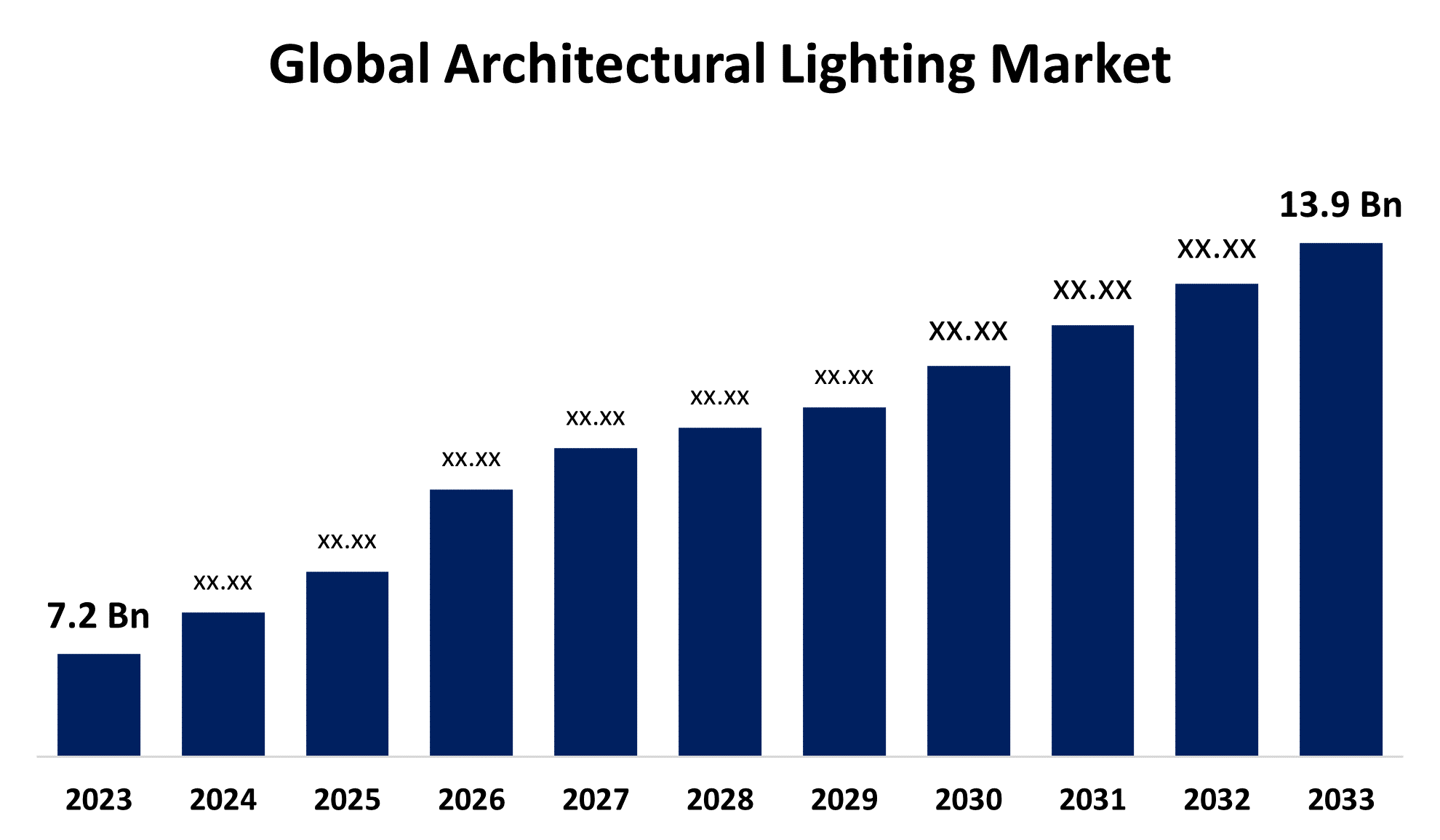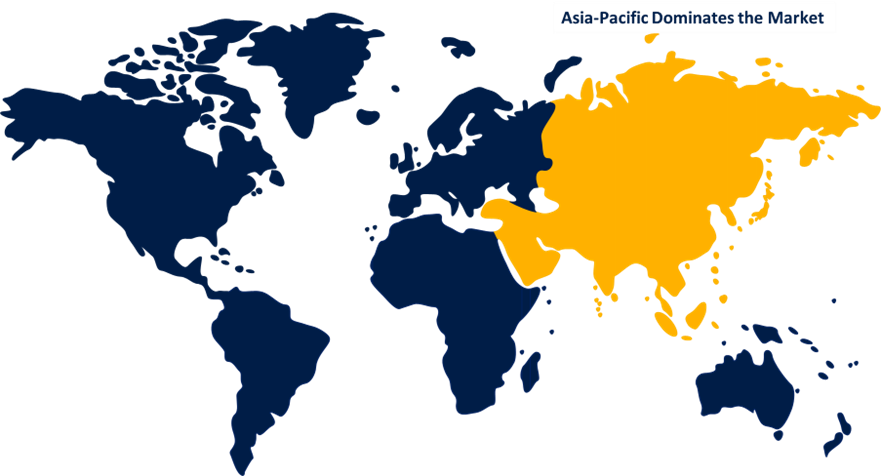Global Architectural Lighting Market Size, Share, and COVID-19 Impact Analysis, By Source (Incandescent Lights, Fluorescent Lights, Light-Emitting Diode (LED), High-Intensity Discharge (HID), Others), By Application (Indoor and Outdoor), By End-use (Commercial, Residential, Industrial, and Others), and By Region (North America, Europe, Asia-Pacific, Latin America, Middle East, and Africa), Analysis and Forecast 2023 - 2033
Industry: Semiconductors & ElectronicsGlobal Architectural Lighting Market Insights Forecasts to 2033
- The Global Architectural Lighting Market Size was Valued at USD 7.2 Billion in 2023
- The Market Size is Growing at a CAGR of 6.8% from 2023 to 2033
- The Worldwide Architectural Lighting Market Size is Expected to Reach USD 13.9 Billion by 2033
- North America is Expected to Grow the fastest during the forecast period.

Get more details on this report -
The Global Architectural Lighting Market Size is Anticipated to Exceed USD 13.9 Billion by 2033, Growing at a CAGR of 6.8% from 2023 to 2033.
Market Overview
Architectural lighting is the art and science of illuminating buildings and spaces to improve their aesthetics, functionality, and overall atmosphere. Lighting fixtures are strategically placed and designed to highlight architectural features, create moods, and support the purpose of a space, whether it is residential, commercial, or public. Different from standard lighting, which only provides illumination, architectural lighting complements the architecture by emphasizing textures, forms, and materials. Architectural lighting is essential for both indoor and outdoor settings. For e.g., in a modern office building, it can boost productivity by providing a well-lit, comfortable workspace, whereas in a historical landmark, it can be used to highlight the building's unique structural details. Exterior architectural lighting can add drama and prominence to a building at night, altering how it is perceived and experienced. The use of innovative lighting technologies, such as LED systems and smart lighting controls, has increased the possibilities for architectural lighting, allowing for more energy-efficient and dynamic solutions. Lastly, architectural lighting is a very essential component of modern designs, combining functionality as well as artistic expression to create visually appealing and functional spaces.
Report Coverage
This research report categorizes the market for the global architectural lighting market based on various segments and regions forecasts revenue growth and analyzes trends in each submarket. The report analyses the key growth drivers, opportunities, and challenges influencing the global architectural lighting market. Recent market developments and competitive strategies such as expansion, product launch, and development, partnership, merger, and acquisition have been included to draw the competitive landscape in the market. The report strategically identifies and profiles the key market players and analyses their core competencies in each sub-segment of the global architectural lighting market.
Global Architectural Lighting Market Report Coverage
| Report Coverage | Details |
|---|---|
| Base Year: | 2023 |
| Market Size in 2023: | USD 7.2 Billion |
| Forecast Period: | 2023-2033 |
| Forecast Period CAGR 2023-2033 : | 6.8% |
| 2033 Value Projection: | USD 13.9 Billion |
| Historical Data for: | 2019-2022 |
| No. of Pages: | 198 |
| Tables, Charts & Figures: | 112 |
| Segments covered: | By Source, By Application, By End-use, By Region |
| Companies covered:: | Acuity Brands, Inc., Environmental Lights, Siemens, GE Current, GVA Lighting, Hubbell, OSRAM GmbH, Panasonic Corporation, Signify Holding, Siteco GmbH, Technical Consumer Products, Inc., Zumtobel Group AG, Feilo Sylvania, TCP International Holdings Ltd., Seoul Semiconductor Co., Ltd., and Others Key Vendors. |
| Pitfalls & Challenges: | COVID-19 Empact, Challenges, Future, Growth, & Analysis |
Get more details on this report -
Driving Factors
Increasing demand for energy efficiency.
With an increasing awareness of environmental concerns and the need to reduce energy consumption, architectural lighting manufacturers are focusing on developing products that are more efficient have a longer lifespan, and usage of less power. Governments and regulatory bodies all over the world are also applying severe energy efficiency standards, incentivizing industries and consumers to choose sustainable lighting solutions. This push for energy-efficient lighting not only aligns with environmental goals but also helps users reduce operative costs, making it an important driver in determining the market's direction.
Restraining Factors
Compliance and regulatory challenges
Navigating diverse and changing regulations on energy efficiency, safety, and environmental impact can raise costs, limit design options, and slow the adoption of advanced architectural lighting technologies.
Market Segmentation
The global architectural lighting market share is classified into source, application, and end-use.
- The Light-Emitting Diode (LED) segment is expected to hold the largest share of the global architectural lighting market during the forecast period.
Based on the source, the global architectural lighting market is categorized into incandescent lights, fluorescent lights, light-emitting diode (LED), high-intensity discharge (HID), and others. Among these, the light-emitting diode (LED) segment is expected to hold the largest share of the global architectural lighting market during the forecast period. The rapid evolution of LED technology has been a significant driver of its adoption in architectural lighting. LEDs have become more efficient, dependable, and adaptable, with increased brightness, color accuracy, and durability. These advancements have made LEDs a viable alternative to traditional lighting sources like incandescent and fluorescent bulbs. Furthermore, the cost of LED technology has dropped significantly over the years as a result of economies of scale and technological advancements, making LEDs more accessible to a larger market. As a result, architects and designers are increasingly using LED lighting in new constructions and retrofits.
- The indoor segment is expected to grow at the fastest CAGR during the forecast period.
Based on the application, the global architectural lighting market is categorized into indoor and outdoor. Among these, the indoor segment is expected to grow at the fastest CAGR during the forecast period. With global population growth and current urbanization, the number of residential projects is gradually increasing. This trend is creating significant growth opportunities for architectural lighting, particularly in indoor situations such as residential and commercial spaces, including office lighting. As more homes and buildings are built, there is a growing demand for innovative and efficient lighting solutions that meet both functional needs and aesthetic preferences. This increase in construction activity not only stimulates the architectural lighting market but also drives advancements in lighting technology to meet the diverse needs of modern living and working environments.
- The commercial segment is expected to grow at the fastest CAGR during the forecast period.
Based on the end-use, the global architectural lighting market is categorized into commercial, residential, industrial, and others. Among these, the commercial segment is expected to grow at the fastest CAGR during the forecast period. The constant growth of commercial development, particularly in the hospitality industry, is driving up demand for outdoor landscape and architectural lighting. As the real estate industry grows, aided by ongoing infrastructure development, there is a greater demand for innovative and appealing outdoor lighting solutions. Hotels, resorts, and other commercial establishments are investing in sophisticated lighting designs to improve their outdoor spaces, making them more inviting and visually appealing. This trend not only stimulates the architectural lighting market, but also encourages the use of advanced lighting technologies that are compatible with modern design and energy efficiency standards.
Regional Segment Analysis of the Global Architectural Lighting Market
- North America (U.S., Canada, Mexico)
- Europe (Germany, France, U.K., Italy, Spain, Rest of Europe)
- Asia-Pacific (China, Japan, India, Rest of APAC)
- South America (Brazil and the Rest of South America)
- The Middle East and Africa (UAE, South Africa, Rest of MEA)
Asia Pacific is projected to hold the largest share of the global architectural lighting market over the forecast period.

Get more details on this report -
Asia Pacific is projected to hold the largest share of the global architectural lighting market over the forecast period. Asia Pacific market is primarily driven by rapid urbanization, economic growth, and infrastructure development. Also, the region's massive population base and growing middle class are driving up demand for architectural lighting in the residential, commercial, and industrial sectors, boosting market growth. Apart from that, the region is a hub for lighting manufacturing and technological innovation, making it a major player in both architectural lighting production and consumption. Furthermore, regional governments actively promote energy-efficient lighting through a variety of initiatives and investments, particularly in smart city projects, which are driving market growth.
North America is expected to grow at the fastest CAGR growth of the global architectural lighting market during the forecast period. In North America, the architectural lighting market is distinguished by advanced technology adoption and a strong importance on energy-efficient and intelligent lighting solutions. Additionally, the presence of many leading lighting manufacturers, a well-established infrastructure, and widespread consumer awareness of energy conservation and sustainable practices all contribute to market growth.
Competitive Analysis:
The report offers the appropriate analysis of the key organizations/companies involved within the global architectural lighting market along with a comparative evaluation primarily based on their product offering, business overviews, geographic presence, enterprise strategies, segment market share, and SWOT analysis. The report also provides an elaborative analysis focusing on the current news and developments of the companies, which includes product development, innovations, joint ventures, partnerships, mergers & acquisitions, strategic alliances, and others. This allows for the evaluation of the overall competition within the market.
List of Key Companies
- Acuity Brands, Inc.
- Environmental Lights
- Siemens
- GE Current
- GVA Lighting
- Hubbell
- OSRAM GmbH
- Panasonic Corporation
- Signify Holding
- Siteco GmbH
- Technical Consumer Products, Inc.
- Zumtobel Group AG
- Feilo Sylvania
- TCP International Holdings Ltd.
- Seoul Semiconductor Co., Ltd.
- Others
Key Market Developments
- In June 2024, Environmental Lights introduced the Cove Wash-Dual Bend LED lighting products, an innovative solution to improve cove lighting installations.
- In February 2024, Siemens, Enlighted, and Zumtobel Group have formed a strategic partnership to advance smart building technologies, with a particular focus on intelligent IoT lighting solutions. The partnership's goal is to set new standards for efficiency and sustainability in global building operations.
Key Target Audience
- Market Players
- Investors
- End-users
- Government Authorities
- Consulting And Research Firm
- Venture capitalists
- Value-Added Resellers (VARs)
Market Segment
This study forecasts revenue at global, regional, and country levels from 2020 to 2033. Spherical Insights has segmented the global architectural lighting market based on the below-mentioned segments:
Global Architectural Lighting Market, By Source
- Incandescent Lights
- Fluorescent Lights
- Light-Emitting Diode (LED)
- High-Intensity Discharge (HID)
- Others
Global Architectural Lighting Market, By Application
- Indoor
- Outdoor
Global Architectural Lighting Market, By End-use
- Commercial
- Residential
- Industrial
- Others
Global Architectural Lighting Market, By Regional
- North America
- US
- Canada
- Mexico
- Europe
- Germany
- UK
- France
- Italy
- Spain
- Russia
- Rest of Europe
- Asia Pacific
- China
- Japan
- India
- South Korea
- Australia
- Rest of Asia Pacific
- South America
- Brazil
- Argentina
- Rest of South America
- Middle East & Africa
- UAE
- Saudi Arabia
- Qatar
- South Africa
- Rest of the Middle East & Africa
Frequently Asked Questions (FAQ)
-
1.What is the CAGR of the global architectural lighting market over the forecast period?The Global Architectural Lighting Market Size is Expected to Grow from USD 7.2 Billion in 2023 to USD 13.9 Billion by 2033, at a CAGR of 6.8% during the forecast period 2023-2033.
-
2.Which region is expected to hold the highest share in the global architectural lighting market?Asia Pacific is projected to hold the largest share of the global architectural lighting market over the forecast period.
-
3.Who are the top key players in the architectural lighting market?The top key players in the global architectural lighting market are Acuity Brands, Inc., Environmental Lights, Delta Light, GE Current, GVA Lighting, Hubbell, OSRAM GmbH, Panasonic Corporation, Signify Holding, Siteco GmbH, Technical Consumer Products, Inc., Zumtobel Group AG, Feilo Sylvania, TCP International Holdings Ltd., Seoul Semiconductor Co., Ltd., Others.
Need help to buy this report?